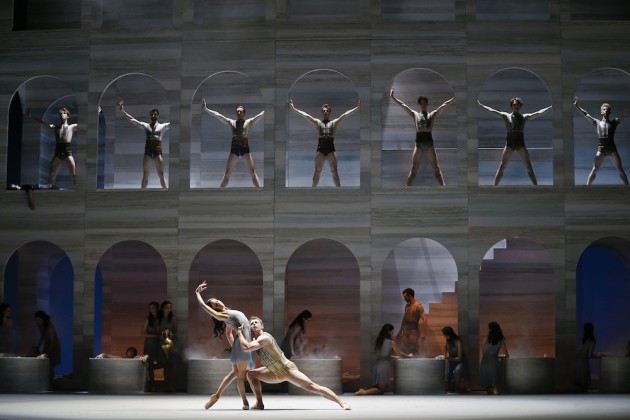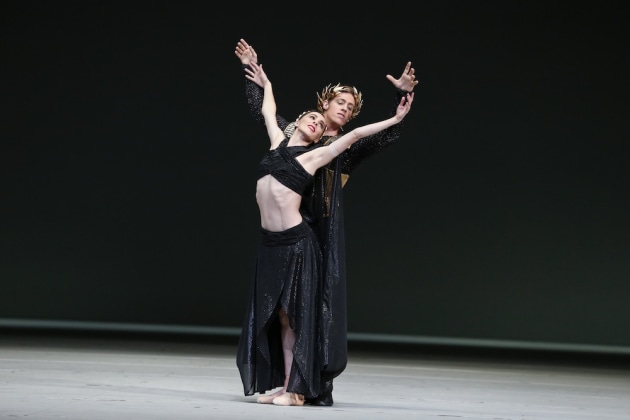The Australian Ballet, Spartacus
Melbourne Arts Centre, September 18
Spartacus has been billed as the premier event in The Australian Ballet calendar for 2018 and there was a definite frisson of anticipation on opening night. This brand new production presents a new choreographer's take on the story of Spartacus, a Thracian slave who rebelled against his Roman masters and whose rebel army survived for two years before being mercilessly crushed. The publicity promised a contemporary take on the story, playing up its relevance to the present day. In the event, this retelling of Spartacus' uprising stays close to the previous ones (with the possible exception of Yacobson's version, which unsuccessfully attempted a very different type of dance drama on the subject). Lucas Jervies has not veered far from the blockbuster elements and heightened pathos of, for instance, the notable and powerful version by Grigorovich which became a virtual calling card for the Bolshoi. In short, the similarities between this new version and the preceding ones are far greater than the differences, but that is no bad thing. The story of Spartacus does not require updating or justifying – its theme of the uprising of the oppressed against their oppressors is no less relevant today.
The opening stage picture, with its stark minimalist set, does not disappoint. A pyramidal structure surmounted by a giant pointing hand works as a representation of brute power with fascist overtones. The flag waving ranks reinforce the image and the stage is set for an epic production. The lighting (Benjamin Cisterne) is consistently impressive. Spartacus lit up at the top of the toppled symbol of power, and Crassus and Tertulla silhouetted in their final entrance readily spring to mind as powerfully dramatic images. The costumes (Jérôme Kaplan) are an interpretation of Roman tunics and togas, with the slave girls' tunics perhaps working best. The vertical sets (Kaplan again) allow for an excellent use of different levels of action. The crucifixion scene at the end, which can so easily misfire, is starkly and horrifyingly moving with the entrance of the bloodied rebels, although Flavia's drawn out final solo cannot match its impact and risks dissipating the horror.

Jervies tells the story on a monumental scale, and the overall impression is cinematic with Hollywood-esque moments, such as the Roman bath scene. There is drama and pathos aplenty, with good concepts. The men are self-evidently the stars of Spartacus although the slave girls' dances are a choreographic highlight, showing a nice musicality. Otherwise the choreography is mixed. The fight scenes aim for a degree of realism just not possible in theatre – after all the violence has to be simulated. The gladiators' sequence of movements – reminiscent of the haka – were not convincing, and the crowd scenes looked too sparsely populated to create their full impact. The main problem, though, was that the choreography is oversaturated with movements, and this has the effect of evening out the drama. There is little space to allow us – or the dancers – to breathe, to be still, to allow the emotional impact of the action to register. Tertulla's solo variation is a case in point. There are just too many movements, and the solo loses out because of that. The ballet thus becomes less moving than it could be and than it ought to be. The stillness of the tortured rebels on their pedestals is one instance where the emotion does have time to travel and it is a very powerful moment indeed. Less can often be more and the greatest masters know that.

All in all it was a praiseworthy effort at an epic story ballet. Kevin Jackson gave a masterful performance as Spartacus. On stage almost constantly, he built a character you could believe in and his dancing and interpretation never flagged, staying strong and engaging throughout. Robyn Hendricks, with her finely sculpted limbs, was exquisite as usual as Flavia, her slender fineness belying her strength.
Amy Harris, newly promoted to principal on the night, gave her all as Tertulla despite some thankless choreography, while Ty King-Wall impressed from his first entrance as the not quite so villainous Crassus, imperious and more than capable of wielding power. His dancing never faltered.
- Irina Kuzminsky
Pictured top are Kevin Jackson as Spartacus and Robyn Hendricks as Flavia. Photo: Jeff Busby.
Spartacus plays Arts Centre Melbourne until September 29, before heading to the Sydney Opera House, November 9-24. Check out a sneak preview of Nina Levy's interview with choreographer Lucas Jervies here and read the full interview in the October/November '18 issue, out very soon!



